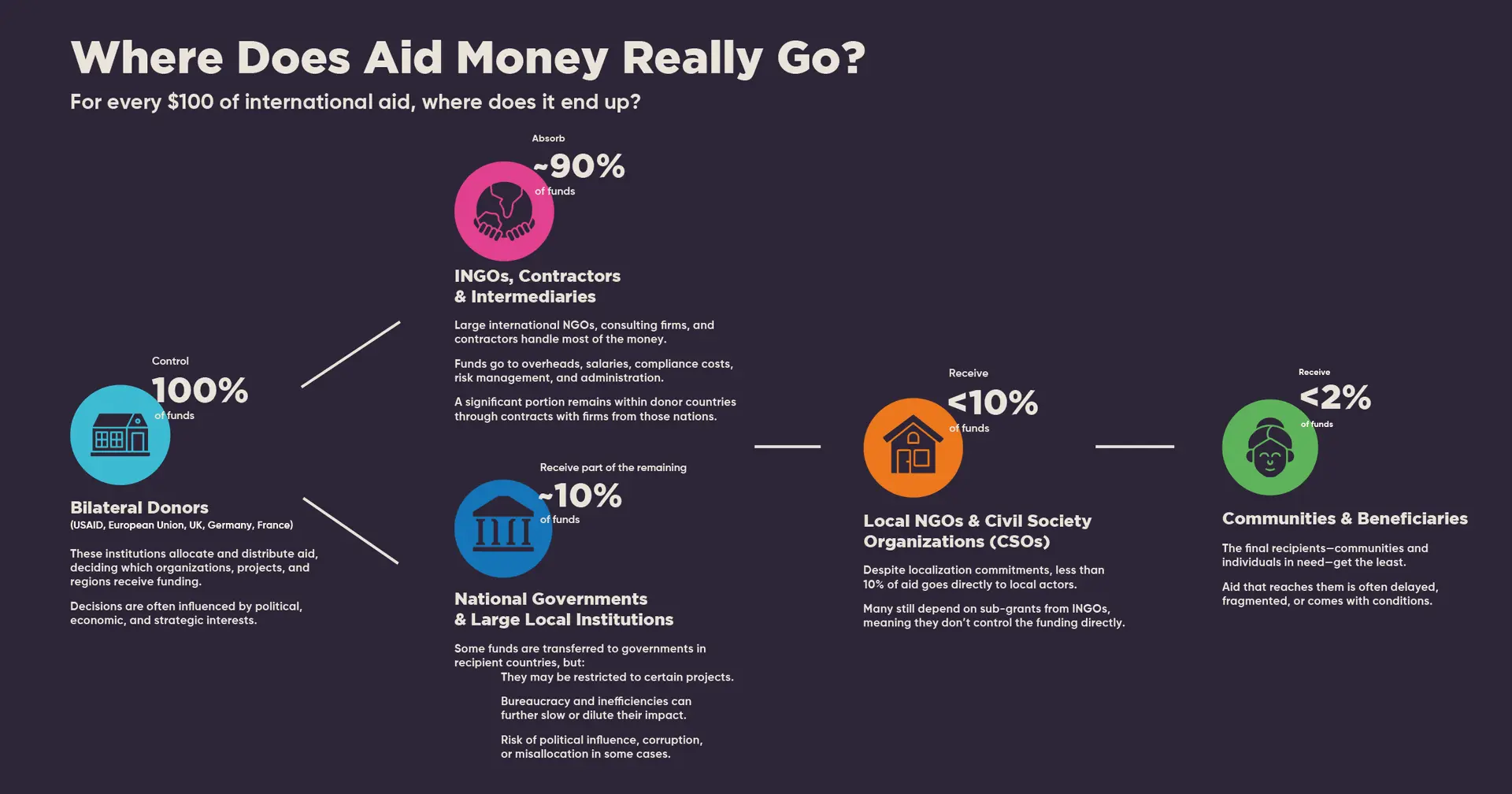While international aid is meant to alleviate suffering and support communities in crisis, the majority of funds never reach those most in need. Instead, aid is trapped in a cycle where large international NGOs (INGOs), contractors, and intermediaries absorb most of the funding, leaving only a fraction for local organizations and an even smaller portion for direct community support.
Recent funding cuts in the aid sector have had a significant impact, happening suddenly and with little warning. In this blog post, we discussed how USAID's funding freeze is affecting the sector—here we break down how funding moves through the system and how these cuts are already affecting different countries and sectors.

This infographic shows how money flows through the aid sector from large bilateral donors to communities. Note that this is a simplification of the reality of aid funding, focusing on a slice of the larger aid/development funding landscape. We recognize that funding flows are often more nuanced.
- Bilateral Donors (e.g., USAID, ECHO, FCDO, GIZ) Control 100% of Funds
These institutions decide which organizations, regions, and programs receive funding, often influenced by political, economic, and strategic interests. - International NGOs and Contractors Absorb up to 90% of Funds
If bilateral donors allocate $100, then up to $90 is distributed among INGOs and contractors. The bulk of this aid never leaves donor countries, flowing instead to consulting firms, INGOs, and contractors that handle administrative costs, salaries, compliance, and risk management. - National Governments Receive ~10% of Funds
For every $100, approximately $10 is allocated to national governments. Some of this funding reaches government institutions in recipient countries, but it is often restricted to specific projects and hindered by bureaucracy, inefficiencies, and political risks (Development Initiatives, 2023). - Local NGOs & Civil Society Receive Less than 10% of the Original Funds
Despite global commitments to localization, less than 10% of total aid is given directly to local actors. Many depend on sub-grants from INGOs, meaning they have little autonomy over funding decisions (DevEx, 2024). - Communities & Beneficiaries Receive Less than 2% of the Original Funds
The people who need aid most get the least. The funding that does reach them is often delayed, fragmented, and comes with conditions (The New Humanitarian, 2025).
The current system benefits powerful INGOs and donor-driven priorities, reinforcing a colonial structure where decisions are made far from the communities they impact. As long as funding remains centralized in donor countries, aid will continue to prioritize the interests of international organizations over those of the people it is meant to help(IASC, 2024).
For more information about how the pattern of colonial inequalities in aid and development funding has grown overtime, check out the Kuja free e-learning course about the History of the Inequality of Aid & Development.
When major donors suspend or cut aid, the effects are immediate and devastating. Many INGOs rely on 40-90% of their budgets from bilateral donors (Development Initiatives, 2023). A funding freeze leads to massive program cuts, global layoffs, and shutdowns, leaving humanitarian efforts in disarray when INGOs and contractors lose funding.
Local organizations already receive little direct funding, mostly through sub-grants from INGOs and contractors. When international donors freeze aid, this support is eliminated. Many are forced to close, worsening crises on the ground, because essential community programs are shut down and millions are left without support.

As shown in the visual above, the funding freeze has widespread consequences. Across Ukraine, Ethiopia, the Democratic Republic of the Congo (DRC), Sudan, Somalia, Haiti, and Afghanistan, the aid freeze has halted food programs, cut medical services, and weakened governance and security initiatives. The World Food Programme (WFP) has already halved food rations for over a million Rohingya refugees in Bangladesh, citing insufficient funding from major donors, including the U.S.(The Guardian, 2025).
In the DRC, a mysterious Ebola-like disease is spreading rapidly, with over 60 deaths and 1,000 infections reported. The crisis is being worsened by USAID cuts, which have severely impacted disease surveillance and emergency response systems(Wired, 2025).
In Sudan, the complete shutdown of USAID-funded emergency response programs has resulted in mass starvation, with millions now deprived of essential food assistance. Famine is escalating, increasing mortality rates and disease outbreaks as humanitarian organizations scramble to fill funding gaps(Time, 2025).
Meanwhile, in South Sudan, Zimbabwe, and South Africa, the withdrawal of USAID funding has forced the closure of clinics and HIV/AIDS treatment programs, leaving millions without access to life-saving medications (Deutsche Welle, 2025).
In Haiti, Colombia, and the Northern Triangle (Guatemala, Honduras, El Salvador), aid reductions have severely weakened migration programs, food security initiatives, and education efforts, increasing violence, displacement, and instability. In Serbia and Moldova, the cuts have also disrupted democracy programs and independent media, exposing these countries to increased authoritarian influence and external destabilization (Observatorio Balcani e Caucso, 2025).
These examples are only some of those reported, as community-impact is not being captured routinely across the globe.
Experts warn that the USAID funding freeze could cost thousands of lives as malnutrition, disease outbreaks, and healthcare collapses worsen in fragile states. With healthcare access, food security, and humanitarian programs severely impacted, the situation is expected to deteriorate further unless funding is restored (The Guardian, 2025).
Join the Conversation
We will be hosting a series of webinars to uncover more about the community-level impacts of these funding freezes and explore how local organizations are working to sustain their communities despite these challenges. Check out our Events section, where we announce each webinar. Sign up to stay informed and join the conversation!
Related Posts:
International Aid Is Crumbling—Some Think This Is an Opportunity
The End of Aid? Understanding the USAID Shutdown and its Global Impact
Localisation is More Important Than Ever. Platforms Like Kuja Can Help